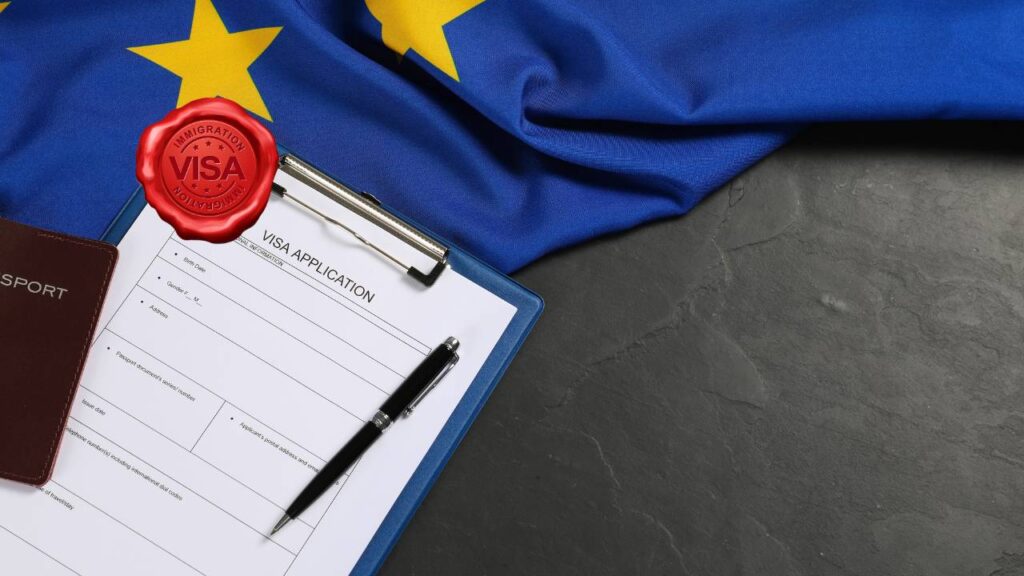To travel to Europe in 2025, it’s essential to have a clear and complete understanding of the Schengen Visa Process. Whether trip involves tourism, business meetings, study, family reunions, or transit through a European airport, a Schengen Visa allows you to travel freely across 27 European countries that are part of the Schengen Area.
This offers a complete breakdown of the Schengen Visa Process for 2025, including detailed information on the required documents, visa interview procedures, updated fee structures, and estimated processing timelines. Preparing well in advance and following each step carefully will significantly increase your chances of a successful visa approval and allow you to visit Europe with confidence.
What is the Schengen Visa?
The Schengen Visa is a short-stay visa that permits individuals to travel within the Schengen Zone for up to 90 days within any 180-day period. This visa grants access to 27 European countries that have abolished internal borders for easier movement of people, effectively functioning as a single country for international travelers. These countries include France, Germany, Italy, Spain, the Netherlands, Switzerland, Belgium, Austria, and more.
The visa is ideal for travelers aiming to visit multiple destinations without the need for separate entry permits. It comes in various categories, such as:
- Tourist Visa – For leisure travel, sightseeing, and vacation purposes.
- Business Visa – For attending professional meetings, business conferences, or industry exhibitions.
- Student Visa – For short academic programs, exchange semesters, or language courses.
- Family Visit Visa – For those visiting relatives or friends residing in the Schengen Zone.
- Airport Transit Visa – Required for transiting through Schengen airports when en route to non-Schengen countries.
Choosing the right visa category is fundamental, as misapplying can lead to rejection. Always review your travel purpose and select the appropriate category to align with your trip objectives.
Schengen Visa Process 2025 – Step-by-Step Guide
The Schengen Visa Process in 2025 is designed to offer efficiency while upholding strict standards for eligibility. Despite the digitization of parts of the system, it remains important for applicants to pay close attention to each detail. The process can differ slightly depending on the country you are applying to, so always refer to that country’s consulate or visa application center (e.g., VFS Global or TLSContact).
1. Choose the Right Schengen Visa Type
Determining the correct visa type is the first step. Clearly define the purpose of your visit—whether it’s tourism, education, business, or family. For example, attending a week-long training program in Spain will require a Student Visa, not a Tourist Visa. If you’re visiting multiple countries, apply at the embassy of the country where you will stay the longest. If the stay is of equal length in multiple countries, apply to the consulate of the country you plan to enter first. Submitting to the wrong consulate is a common error that results in processing delays or outright denial.
2. Prepare the Required Documents
Your application is only as strong as your documentation. Each document must be current, verifiable, and formatted as per embassy guidelines. Inaccurate or missing documents are the most common reasons for rejections.
General Mandatory Documents:
- Visa Application Form: Accurately filled and signed.
- Passport: Valid for at least 3 months beyond departure from Schengen, issued within the last 10 years, with at least two blank pages.
- Photographs: Two passport-sized photos (35x45mm), taken within the last six months, meeting biometric standards.
- Travel Itinerary: Round-trip reservation indicating dates, flight numbers, and Schengen entry/exit points.
- Proof of Accommodation: Hotel bookings or invitation letter from a host along with their ID/passport copy and residency status.
- Travel Insurance: With minimum coverage of €30,000, covering all Schengen countries, valid for the entire stay.
- Proof of Financial Means: Recent 3–6 months of bank statements, salary slips, or tax returns. If sponsored, provide a sponsorship letter and the sponsor’s financial documents.
- Employment/Study Documents: Employer’s NOC, proof of leave, school enrollment letter, and other relevant certifications.
- Cover Letter: Explain your travel itinerary, purpose, and plans for returning to your home country.
Additional Documents By Visa Type:
- Business Visa: Invitation letter, company registration, proof of previous dealings.
- Student Visa: Admission letter, proof of tuition payment, academic credentials.
- Family Visit Visa: Proof of relationship, invitation letter, host’s legal status in the Schengen country.
- Minors: Birth certificate, parental consent letters, guardian identification.
Ensure all documents in foreign languages are translated and certified as required.
3. Book a Visa Appointment at the Embassy or VFS
After gathering all documents, the next step is scheduling an appointment. Slots can fill up quickly, especially during peak travel months. Most embassies require booking via their website or via authorized visa centers like VFS Global. No walk-ins are accepted.
Book at least 4–8 weeks in advance and choose an appointment time that allows buffer days for unexpected document requests or delays. Rescheduling can be difficult, so ensure all documents are in order before booking.
4. Attend the Visa Interview
The visa interview serves to verify your purpose of travel and intent to return. You must present yourself confidently and truthfully.
Interview Questions May Include:
- What is the reason for your visit?
- What is your daily itinerary?
- How will you finance your trip?
- Do you have any dependents or responsibilities in your home country?
Officers assess whether you are a risk for overstaying. Avoid inconsistencies between your documents and verbal answers. Bring originals and extra copies of all documents.
5. Pay the Schengen Visa Fees
Visa fees must be paid in full at the time of submission. These are non-refundable regardless of the outcome. Payment methods vary (card, cash, or online), and additional service fees may apply.
| Applicant Type | Visa Fee (EUR) | Approx. USD |
|---|---|---|
| Adults (12+ years) | €80 | ~$85 |
| Children (6–11 years) | €40 | ~$43 |
| Children under 6 years | Free | $0 |
| Certain nationalities | €35 or waived | Varies |
Always ask for a receipt and keep it for your records.
6. Biometric Data Collection
All first-time Schengen Visa applicants must submit biometric data including fingerprints and a digital photo. This is stored for five years in the Visa Information System (VIS).
Returning applicants may be exempt if their previous biometric data is still valid. Consulates reserve the right to request new data.
Schengen Visa Processing Time in 2025
Standard processing time is 15 calendar days. Certain nationalities or complex cases may take up to 45–60 days. Embassies often experience delays during holiday seasons or school vacations. Applying early (up to 6 months in advance) is highly advisable for travelers with fixed schedules.
After Submission – What Happens Next?
After your application is submitted, it is processed by the embassy or consulate. You will receive a tracking ID to monitor the status online. Once a decision is made:
- If approved: The visa is stamped in your passport with validity dates and number of entries.
- If denied: A letter explaining the reason for denial will be provided. Common reasons include insufficient financial proof, lack of travel insurance, or doubts about your return plans.
You can reapply or file an appeal depending on the reason for refusal. It is crucial to correct the previous mistakes before reapplying.
Tips to Ensure a Successful Schengen Visa Application
- Start your application process early (at least one month in advance).
- Double-check all documents for accuracy and completeness.
- Avoid submitting fake or misleading information.
- Do not book non-refundable tickets until your visa is approved.
- Show clear evidence of ties to your home country.
- Use a professional cover letter to explain your purpose and plan.
Important Updates to the Schengen Visa Process in 2025
- ETIAS Implementation: Citizens of visa-exempt countries will need to apply for ETIAS (European Travel Information and Authorization System) from mid-2025.
- Digital Schengen Visas: Paper visas are gradually being replaced with secure digital visas to reduce fraud and improve security.
- Online Platforms: More consulates are adopting digital platforms for uploading documents and booking appointments, improving convenience.
These advancements are expected to streamline the visa application process while maintaining security and compliance.
Europe Visa Fee & Cost 2025: Price, Charges, Processing Time
With digital innovations and standardized procedures, 2025 promises a more efficient and transparent visa experience. Stay informed, apply early, and make your European travel dreams a reality with careful planning and diligence.
FAQs
1. What is the Schengen Visa and who needs it?
The Schengen Visa is a short-stay visa that allows travelers to enter and move freely within 27 European countries that are part of the Schengen Zone for up to 90 days within a 180-day period. You need this visa if you are a citizen of a country that does not have a visa-free agreement with the Schengen Area.
2. How early should I apply for a Schengen Visa in 2025?
You can apply up to 6 months in advance and no later than 15 working days before your intended travel date. It’s highly recommended to apply at least 4–6 weeks prior to your trip, especially during peak seasons (April–August and November–December) to avoid delays.
3. Which country should I apply to if I’m visiting multiple Schengen states?
You must apply at the embassy or consulate of the country where you will spend the most number of days. If you’re spending equal time in multiple countries, apply to the one which is your first point of entry into the Schengen Area.
4. Do I need to book flight tickets and hotels before getting the visa?
No. You only need to provide flight and hotel reservations, not actual bookings. These are temporary travel itineraries that show your planned route and accommodation—sufficient for the visa application.
5. Is travel insurance mandatory for a Schengen Visa?
Yes, travel insurance is mandatory. It must cover a minimum of €30,000 in medical emergencies, be valid in all Schengen countries, and cover the entire duration of your stay.
6. What are the visa fees in 2025?
- Adults (12+ years): €80 (approx. ₹7,200)
- Children (6–11 years): €40 (approx. ₹3,600)
- Children under 6 years: Free
Additional service charges may apply if applying via VFS or other centers.
7. How long does it take to get the Schengen Visa?
The standard processing time is 15 calendar days from your appointment date. It can take up to 45–60 days if additional verification is needed, especially for applicants with limited travel history or during peak seasons.
8. What if my visa is rejected? Can I appeal?
Yes. If your visa is rejected, you will receive a written explanation. You can appeal the decision to the consulate or reapply with corrected or additional documentation. Make sure to address the reasons stated in the rejection letter.
9. Do I need to attend the visa interview in person?
Yes, all applicants must attend an in-person appointment to submit their documents and biometric data. This includes fingerprints and a digital photograph. Repeat applicants may be exempt if biometrics were submitted within the last 5 years.
10. Can I work or study on a Schengen Tourist Visa?
No, a Tourist Visa only permits leisure travel, sightseeing, or family visits. Working, paid internships, and full-time study are strictly prohibited. For those purposes, you must apply for a national visa or long-term visa of the specific country.






